Reinier Postma, 1/5, home blogger ArtEZ Business Centre
Crossmedia Design, Enschede
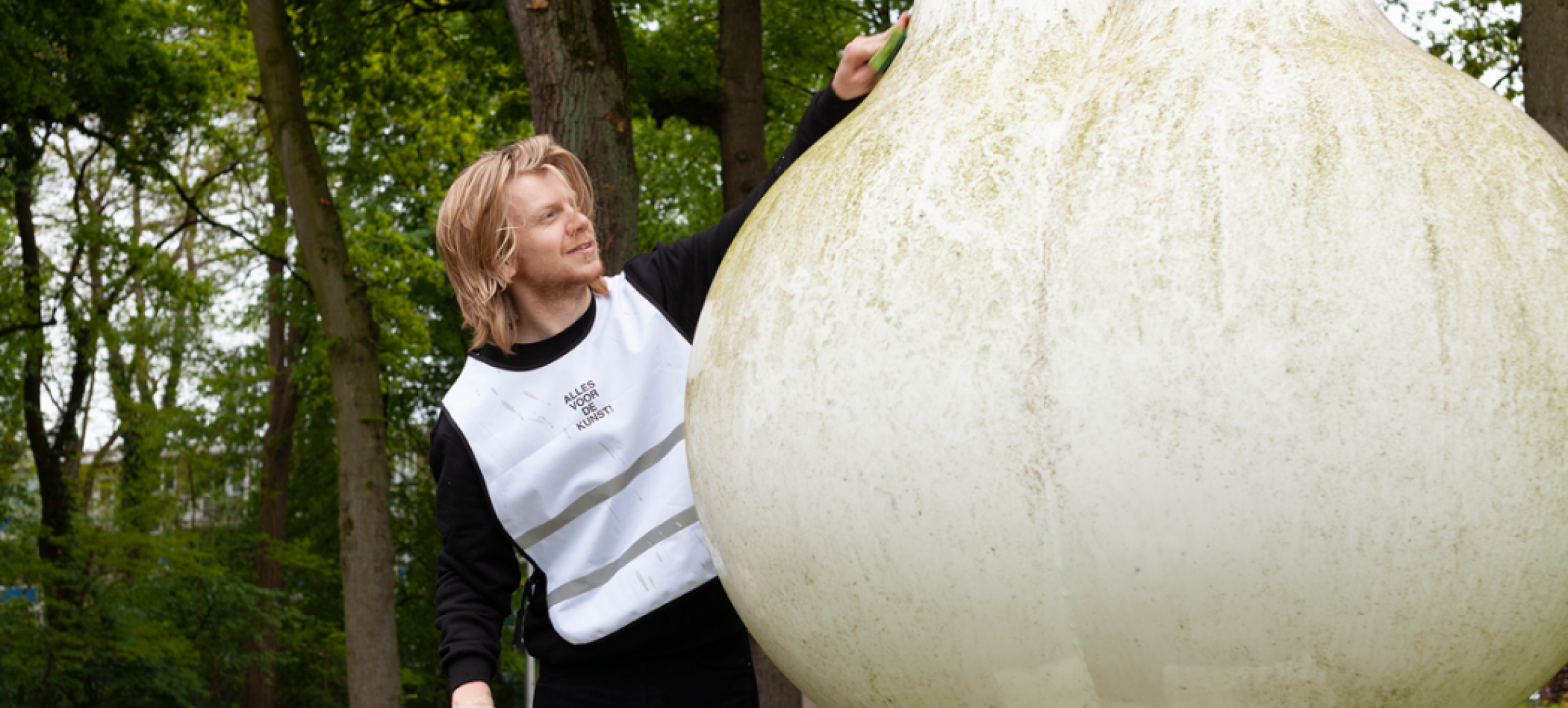
Introduction
Last year I graduated from the AKI ArtEZ in Enschede where I studied Crossmedia Design. My ongoing research concerns how we view and use private and public space. With temporary interventions I reveal the things that we easily overlook in the hubbub of everyday life and I invite others to contemplate them with me. These visual and performative interventions disrupt everyday situations, lead to fresh encounters and open people’s eyes.
My name is Reinier Postma. I was born a little over 25 years ago in the Frysian village of Joure. It’s a small town best known for its large highway junction and the associated traffic jams. But enough about that. I didn’t study civil engineering, but Crossmedia Design at AKI ArtEZ in Enschede. This coming year, I’ll be reporting on my life after the academy.
Before I started my program in Enschede, I studied Media Design at the ROC Friese Poort in Drachten. In my time there, working for various advertising agencies, I learned how to design corporate identities and campaigns for commercial purposes. Working on these commercial commissions didn’t satisfy me enough, however. At the academy I realized that it’s important to me that my concepts and designs are meaningful to society. That realization is reflected in my graduation project Alles voor de kunst! (Everything for art!) in which I used five performative interventions around five public artworks in Enschede to draw attention to our relationship to art in public space, and with that, to public space itself.
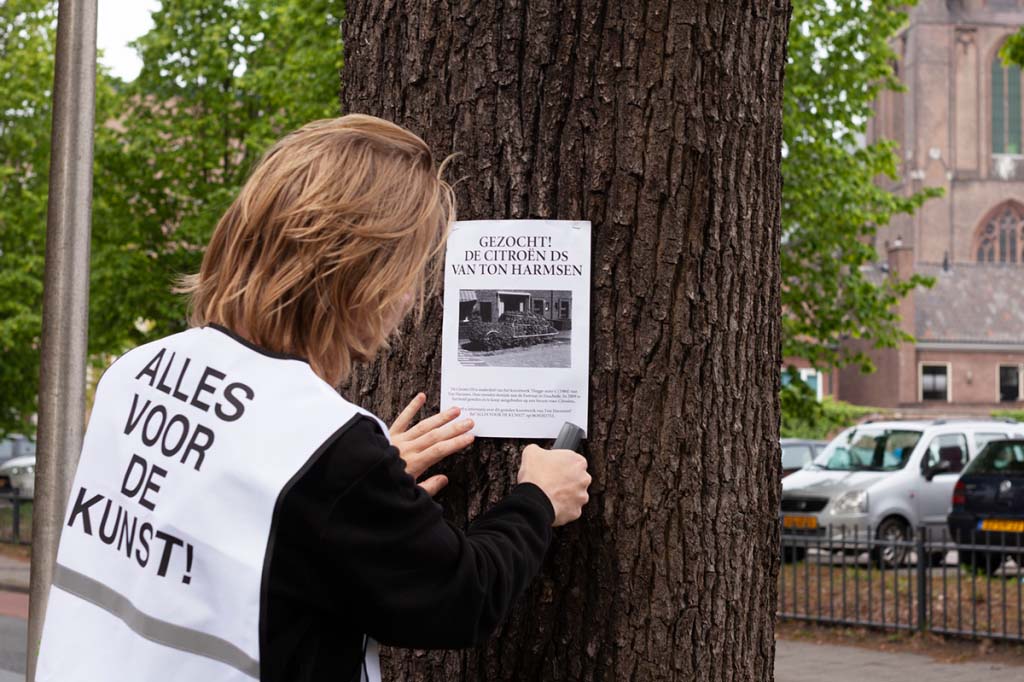
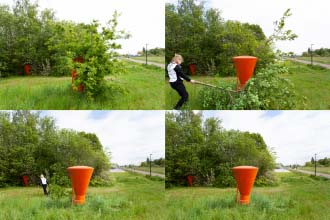 The situation of art in public space in Enschede is alarming. The images below show the five artworks that I campaigned for. The Hegge-cars by Ton Harmsen consists of three metal frames overgrown with shrubbery in the recognizable shapes of a Volkswagen Beetle, a Renault 4 and a Citroën DS. The DS disappeared ten years ago and was never seen again. ‘Dubbele Verdikking’ (Double Thickening), an originally white sculpture by Frans Peeters, had turned green with moss and mold after years of negligence. Then there’s Cone 8 by Paul Devens: a work that consists of eight orange objects, of which only five remained visible. One hass vanished and two others were completely covered by vegetation. Fourth, in the center of Enschede, there is a statue by Alfons Ariëns. It used to be in the middle of a fancy lawn but today you can park your car literally right next to it. Finally, there’s the fountain of Jan van Eijl which has been dry for decades. The decision to turn it off was made by officers of the nearby police station, who were apparently troubled by the splashing.
The situation of art in public space in Enschede is alarming. The images below show the five artworks that I campaigned for. The Hegge-cars by Ton Harmsen consists of three metal frames overgrown with shrubbery in the recognizable shapes of a Volkswagen Beetle, a Renault 4 and a Citroën DS. The DS disappeared ten years ago and was never seen again. ‘Dubbele Verdikking’ (Double Thickening), an originally white sculpture by Frans Peeters, had turned green with moss and mold after years of negligence. Then there’s Cone 8 by Paul Devens: a work that consists of eight orange objects, of which only five remained visible. One hass vanished and two others were completely covered by vegetation. Fourth, in the center of Enschede, there is a statue by Alfons Ariëns. It used to be in the middle of a fancy lawn but today you can park your car literally right next to it. Finally, there’s the fountain of Jan van Eijl which has been dry for decades. The decision to turn it off was made by officers of the nearby police station, who were apparently troubled by the splashing.
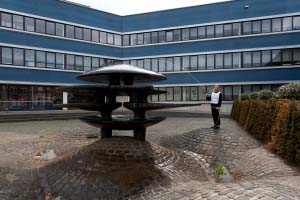
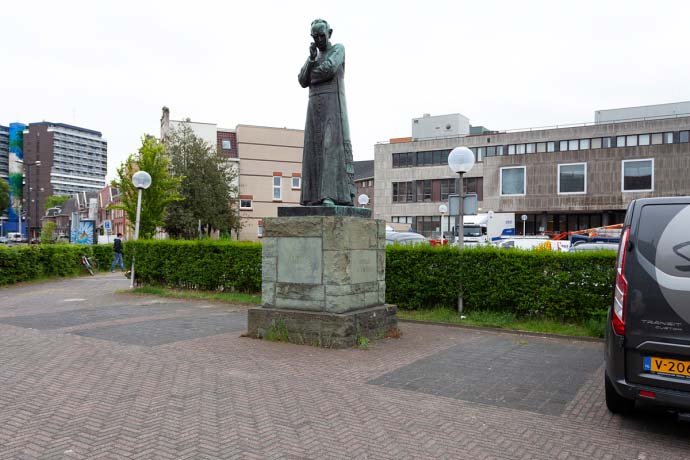
My project and the works of public art got a lot of publicity. I had numerous conversations with locals about the sculptures. I was interviewed by Tubantia about my interventions.
A city council deputy of D66 got furious when he learned that Cone 8 wasn’t reclaimed from the plants as a result of his questions in the council, but due to my intervention. My search for the missing DS led me to rediscover the artwork. I’m working with the council and the artist to restore it to its rightful place. I’ll tell you more about that in my next blog. During the Open Monument Day, I again drew attention to these artworks. I took a number of interested participants on a bike ride around them. Then I had an interview with Rob Janssen of 3FM about my bike tour and graduation project.
What did you expect when you started the program?
In my time at the ROC Friese Poort in Drachten I was mostly concerned with graphic design. At the time it seemed like a logical path to continue doing that, so I decided to continue with a Graphic Design program at the HKU in Utrecht. But I quit after three months; I felt I wasn’t ready to go to art school. I took a year to explore what would be the best next step for me. In that year I took a number of courses and experimented a lot with photography and collage. I found out I wasn’t just passionate about graphic design but also wanted to discover other disciplines that suited me. That’s why I ended up registering for Crossmedia Design, a broad program where I would have classes taught by an architect, an illustrator, a photographer, a philosopher, a graphic designer and many other teachers with varying backgrounds. I assumed that, in that environment, I’d inevitably figure out what direction I’d like to take as an artist or designer.
What have you learned and what would you have liked to change?
I worked on a lot of different projects at ArtEZ: from an installation of ventilators to a bike ride south in search of the significance of the concept of ‘home’. These projects may seem diffuse at first, but I found out that they have a lot in common, too. As I progressed through the program, I became increasingly aware of what interests me as a designer: I kept coming back to our understanding and use of public and private space. Using temporary interventions, I want to make those things visible that are easily overlooked in the hubbub of everyday life and invite others to contemplate them with me. These visual and performative interventions disrupt everyday situations, lead to fresh encounters and open people’s eyes.
In the future I want to keep working on projects that are relevant to society. In retrospect I would have wanted to spend more time during my program thinking about how I would pursue this in practice after graduating from the academy. On the other hand, I used my time as a student as a safe environment to experiment and explore my interests. Now I have plenty of time to think about how I will realize these projects.
What advice would you like to give to new students starting their program?
My advice to new students starting their programs now is: take initiative! Don’t forget that, in the end, you’re doing this for you! When you invest energy and time into your work, you’ll see that it will develop and improve. Create a lot, try everything. That will help you find out your dislikes, as well. Take the time to discuss your work with classmates and teachers, as well as students from other programs. I talked about my work a lot with Fine Arts students and found their input really valuable.
Besides working, I’d also encourage you to visit the library. I spent a lot of time learning about other designers, artists and philosophers. Read books, journals, listen to podcasts, watch documentaries, attend a lecture; you’ll learn about things that interest you and you’ll find out what themes you want to focus on in your own work.
What are your plans for the coming year?
This coming year I want to get to work on some new projects. I also want to continue Alles voor de kunst! and try to get some funding for this project. My new workspace is in Utrecht, where I share a space in a loft with other creative makers. I share this space with two friends, and we’re going to work together on artistic social projects in local neighborhoods through Creative Tinkers: an interest group for community workers seeking to strengthen communities socially and economically. I’m currently working with a friend on a project in an apartment building in Amsterdam Slotervaart; we were asked by a housing corporation how we can involve the residents in remodeling the hallways of the building. I’ll be registering as a creative entrepreneur so I can also get paid for other projects in the future. To be certain of a stable income, I’m also looking for a job for two days a week. I want to ask my readers to help me in my search for housing: are you someone, or do you know anyone, who has an affordable room or studio in or close to Utrecht? Please let me know.
What’s your perspective on entrepreneurship, what does it mean for you and your work?
I worked on various commissions during my program; they’d usually arise by chance and I was happy to take them. Now that I’ve graduated, suddenly entrepreneurship is much more important, since I’d like to work as an independent creative entrepreneur. How should I go about this? How do I apply for funding or find other ways to finance my projects? I’ll be finding out in the coming months. I’m going to have to network to get new commissions. It’s very exciting and stressful but also extremely educational.
Where would you like to be in five years?
I hope I’ll be able to live off my own business and that I’ve built an interesting portfolio of projects that have contributed to society. I also hope I’ll have met more interesting people to cooperate with. I’d also like to do a Masters’ program, but I’m not sure which one yet. Besides working on my projects, I would also really enjoy teaching.
Translation by: Witold van Ratingen
Reinier Postma - Cross Media Desgin AKI Enschede
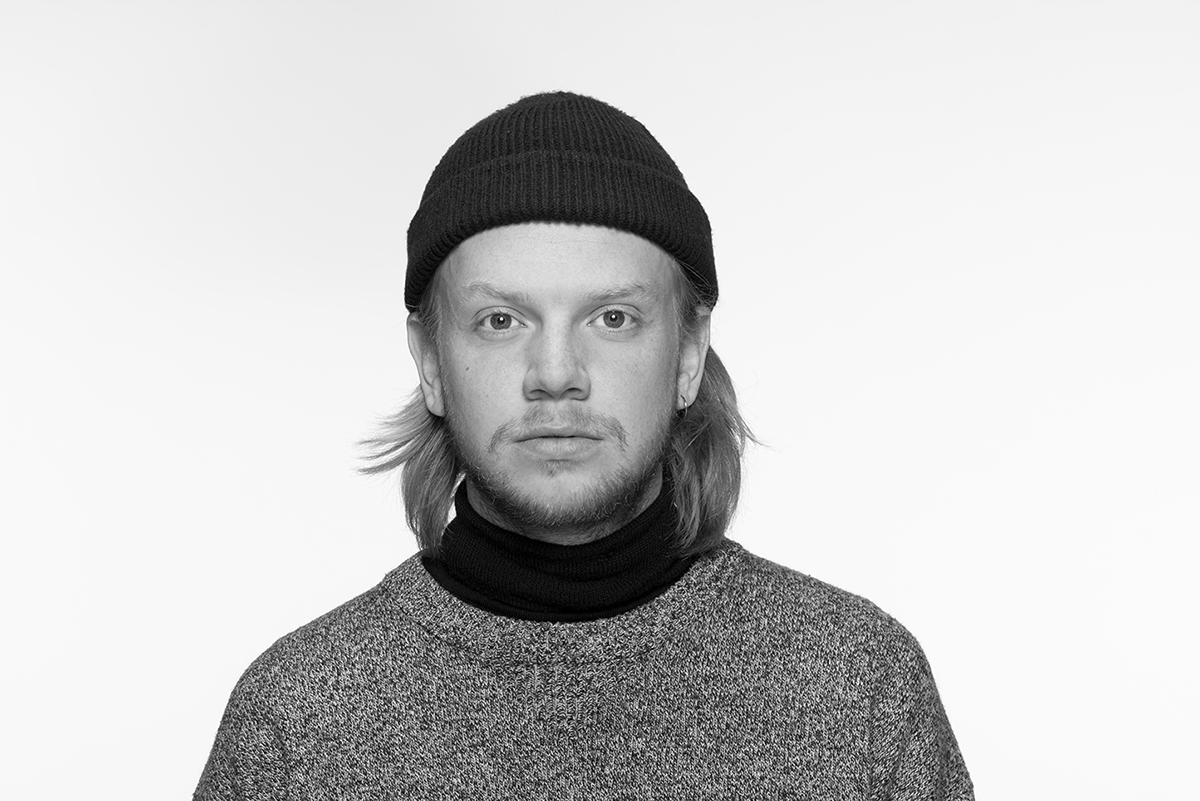 Last year I graduated from the AKI ArtEZ in Enschede where I studied Crossmedia Design. My ongoing research concerns how we view and use private and public space. With temporary interventions I reveal the things that we easily overlook in the hubbub of everyday life and I invite others to contemplate them with me. These visual and performative interventions disrupt everyday situations, lead to fresh encounters and open people’s eyes.
Last year I graduated from the AKI ArtEZ in Enschede where I studied Crossmedia Design. My ongoing research concerns how we view and use private and public space. With temporary interventions I reveal the things that we easily overlook in the hubbub of everyday life and I invite others to contemplate them with me. These visual and performative interventions disrupt everyday situations, lead to fresh encounters and open people’s eyes.